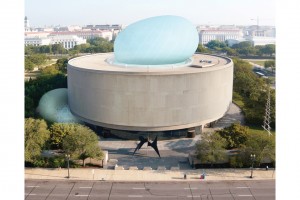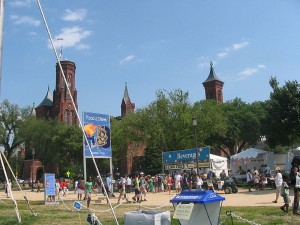The bubble and the tent: Keeping culture accessible at the Smithsonian Institution
01 August 2013 – Will Walker
 With the resignations of the Hirshhorn Museum’s director and the chairman of its board of trustees this summer, the Bubble, or Seasonal Inflatable Structure, project (at left) has collapsed in a very public way. As the Bubble deflated under the weight of its projected costs, the Smithsonian Folklife Festival, a different kind of venue for arts and culture, continued its long run of phenomenal success. (This year’s festival, which ran from June 26 through July 7, featured Hungarian heritage, African American styles of adornment, and speakers of endangered languages.) Although the Bubble’s projected $12.5 million price tag was the most frequently cited reason for its demise, I want to propose an alternative explanation. With the former director’s goal of using the Seasonal Inflatable Structure to host think tanks and Davos-style meetings of the minds, the project bore the taint of elitism and was not a good fit for the Smithsonian.
With the resignations of the Hirshhorn Museum’s director and the chairman of its board of trustees this summer, the Bubble, or Seasonal Inflatable Structure, project (at left) has collapsed in a very public way. As the Bubble deflated under the weight of its projected costs, the Smithsonian Folklife Festival, a different kind of venue for arts and culture, continued its long run of phenomenal success. (This year’s festival, which ran from June 26 through July 7, featured Hungarian heritage, African American styles of adornment, and speakers of endangered languages.) Although the Bubble’s projected $12.5 million price tag was the most frequently cited reason for its demise, I want to propose an alternative explanation. With the former director’s goal of using the Seasonal Inflatable Structure to host think tanks and Davos-style meetings of the minds, the project bore the taint of elitism and was not a good fit for the Smithsonian.
The folklife festival’s open, accessible, and democratic character, on the other hand, makes it a perfect showcase for the institution. An annual tradition since 1967, the festival is extremely popular with the public, routinely attracting hundreds of thousands, and sometimes millions, of visitors. One of its founders, folklorist Ralph Rinzler, dubbed it “A Festival to Cherish Our Differences,” and it has always succeeded in melding a populist feel with a multiculturalist ethos that is neither heavy-handed nor simplistic. The idea behind the festival is straightforward: bring people to the Mall from all over the country and the world to present the rich diversity of human cultures. Visitors are invited, but never pressured, to engage in multiple ways with the festival’s programs–from simply enjoying performances to listening to a lecture or striking up a conversation with a craftsperson. Conversation and dialogue are encouraged; indeed, they are at the heart of the festival’s philosophy.
As I researched the history of the festival for my book–A Living Exhibition: The Smithsonian and the Transformation of the Universal Museum (University of Massachusetts Press, 2013)–listening to countless recordings from the 1960s and ’70s, I heard the incredible power of its dialogic approach. Remarkably, ordinary people freely discussed serious topics, such as Native American land claims and cultural continuities from old world to new, in passionate, yet civil tones as the music of Dewey Balfa or “Sweet Honey in the Rock” hung in the air. The debut festival in 1967 featured a New Orleans brass band, a Navajo sand painter, a folk dance group from North Carolina, a string band from Virginia, Native American dancers from Iowa and Alaska, and a square dance caller from Baltimore.
Relatively small, at least at first, its influence on the Smithsonian would, nevertheless, be significant. At the time the Smithsonian’s leadership was struggling to adapt to the new American cultural landscape ushered in by the civil rights movement at home and decolonization abroad. The festival offered an approach to cultural exhibition that invited people to speak for themselves rather than privileging curators’ perspectives. It was the beginning of a paradigm shift in museums that would lead to projects such as the National Museum of the American Indian and the National Museum of African American History and Culture.

Smithsonian Folklife Festival (Photo: Ser Amantio di Nicolao)
Although the festival is a massive undertaking to organize, its infrastructure (tents, stages, signage, and food concessions) is rather basic. Superficially, it is indistinguishable from the many county fairs that spring up each year across the country. This physical similarity is appropriate as the festival is dusty, hot, exciting, and alive in the same way that county fairs are. Of course, behind the scenes a great deal of fieldwork and research go into selecting and presenting the cultures on display. The festival is a public program with an enormous amount of intellectual heft behind it, but it doesn’t wear its scholarship on its sleeve.
If the Hirshhorn’s leadership had succeeded in carrying the Bubble project to fruition, it would have offered another gathering place for cultural events. Unlike the county fair atmosphere of the festival, the Bubble would have been a high concept and aesthetically striking venue. In the end, however, a showy space for the “best and the brightest,” or, more likely, the most deep pocketed, to share ideas about art and culture was unable to garner broad, public support. It turned out that the Smithsonian didn’t need the Bubble. It already had its own temporary space for the meeting of minds: the Smithsonian Folklife Festival.
~ Will Walker is assistant professor of history at the Cooperstown Graduate Program (State University of New York-Oneonta).




As a former intern for the SI Center for Folklife and Cultural Heritage back in 2008, a fly on the wall as they were gearing up for that year’s festival and having planning meetings for those coming in the next years, I was above all impressed with the institutional cultural in that office. They approach their work daily with that same engaged, honest conversation, with diversity of approach and life experience, with creativity and energy. I had to go home before the festival actually happened, but it’s a dream to pilgrimage back out to the Mall and be part of it someday.
Good essay! I don’t know that it was the elitism that did in the bubble – the Smithsonian has plenty of enthusiasm for elitism, not all of it misguided. I’d read it as a high-concept architectural scheme done in by cost – and by lack of any content. Another space in Washington for people to talk? Lack of conference space is not Washington’s problem.
But the comparison with the Folklife Festival is a good and useful one. In the Folklife Festival the Smithsonian has figured out how to combine the best and most thoughtful scholarship with public engagement. It would be great to see that spirit filter more into the museums, including the Hirshhorn. And one might even imagine that a giant blue bubble is the place that could happen.
As much as I would love to see what Diller Scofidio + Renfro might do with the Hirshhorn building, it’s important that museum expansion needs to be driven by ideas, and ideals, not only by clever architecture. Perhaps this might be an opportunity to rethink those ideas – and to get some of the spirit of the folklife festival into the museums.
It strikes me that the differences here also reflect the audiences and genres of the high-end art museum vs. the outdoor folk festival. Although they’re both part of the Smithsonian, they’re also worlds apart in a lot of ways. But I think that Steve is right about spirit and attitude being able to transcend the inherent elitism of glitzy architecture and high-art institutions. I’m thinking of something like Snohetta’s Oslo Opera House, whose architecture has apparently made it a very welcoming public space that people love to use even if they never go to the opera. (Of course, that was plenty costly, but it was underwritten by a government that solidly supports its artistic sector–so the “attitude” in this case is culture-wide rather than relying on rich donors or highly contested and politicized public funds!)
I agree that branding the project “elitist” may have been an overstatement. I guess it’s a knee-jerk reaction whenever I hear the word “Davos.” The point about elite institutions running successful “populist” programs is a good one. I think of the Metropolitan Museum of Art’s many school programs each year, which are free for all schools within New York City. I should also acknowledge that the Smithsonian’s free admission makes the entire institution more populist than most other museums in the United States.